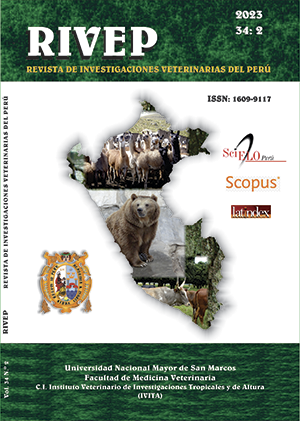Effect of adding ascorbic acid to the vitrification medium of bovine preantral follicles
DOI:
https://doi.org/10.15381/rivep.v34i2.25100Keywords:
ascorbic acid, cryopreservation, morphology, ovary, viabilityAbstract
The aim of this study was to evaluate the effect of adding ascorbic acid (AA) to the vitrification medium of bovine preantral follicles (PFs) subjected previously to cooling at 4 °C for 4 h or 24 h. Ovaries were collected from Nelore heifers at 14 months of age. In the laboratory, ovarian fragments were removed from the cortical region and distributed to fragments as fresh control (C0h), and fragments to cooling at 4 ºC for 4 and 24 hours in TCM-199 plus HEPES and antibiotics. Of the cooled fragments, two were fixed as controls for each cooling time (C4h, C24h), and the remaining fragments were distributed in four vitrification treatments, using the TCM-199 medium associated with ethylene glycol and dimethyl sulfoxide (V), sucrose (VSUC) or ascorbic acid (VAA), and the treatment with ethylene glycol, dimethyl sulfoxide, sucrose and AA (VSUC+AA). After 72 h, fragments were warmed and fixed for histological analysis and mechanical follicular isolation. No difference (p>0.05) between C0h and C4h for morphologically normal PFs was detected (99.3 and 96.0%, respectively). Vitrification reduced the morphological integrity and follicular viability in all treatments compared to C0h; nevertheless, VAA treatment maintained the follicular viability like C24h (p>0.05). It is concluded that bovine PFs were conserved efficiently at 4 °C during 4 h, and the addition of ascorbic acid to the vitrification medium improved survival rates and kept the morphological integrity of the follicles.
Downloads
Downloads
Published
Issue
Section
License
Copyright (c) 2023 Erly L. Carrascal-Triana, Carolina Rodríguez Jimenez, Jurandy Penitente-Filho, Jovana Luiza de Azevedo, Renata Gomes da Silveira Deminicis, Ciro A. Alves Torres

This work is licensed under a Creative Commons Attribution 4.0 International License.
AUTHORS RETAIN THEIR RIGHTS:
a. Authors retain their trade mark rights and patent, and also on any process or procedure described in the article.
b. Authors retain their right to share, copy, distribute, perform and publicly communicate their article (eg, to place their article in an institutional repository or publish it in a book), with an acknowledgment of its initial publication in the Revista de Investigaciones Veterinarias del Perú (RIVEP).
c. Authors retain theirs right to make a subsequent publication of their work, to use the article or any part thereof (eg a compilation of his papers, lecture notes, thesis, or a book), always indicating the source of publication (the originator of the work, journal, volume, number and date).



